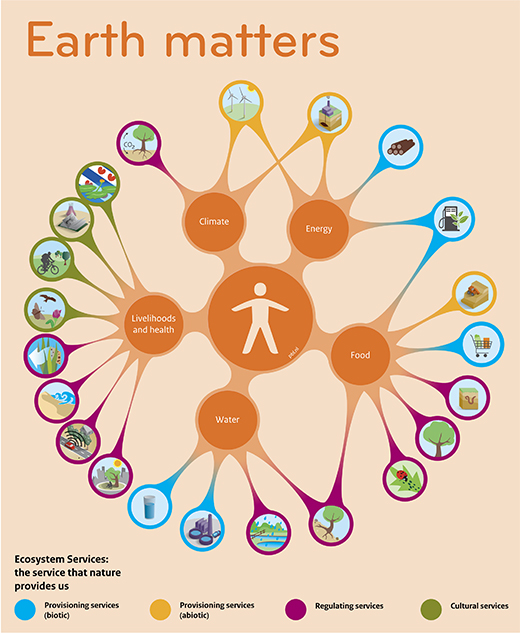PBL Netherlands Environmental Assessment Agency has created an infographic publication, titled ‘People and the Earth,’ which addresses the SDG challenge in the form of a triptych, discussing 1) humans’ critical dependence on the Earth; 2) integrated solutions for nexus issues between food, water, energy and land; and 3) multi-level and multi-actor governance models for successful cooperation.
For successful implementation, efforts to assess the global challenges, find integrated solutions and create multi-actor partnerships should be brought together, with a specific focus on synergies and cooperation.
Over the last few decades, people have become increasingly aware of the global and systemic nature of many of our environmental problems today. This is recognized in the 2030 Agenda for Sustainable Development and the 17 Sustainable Development Goals (SDGs). The highly interdependent nature of ecological and socio-economic systems makes that the SDGs can only be achieved when different agendas and societal partners are connected, both locally and worldwide, now and in the future. The challenge is, on the one hand, to do justice to the abstract world of the many interdependencies between the SDGs, while, on the other hand, to remain in touch with human imagination, inspiration and collaboration.
To communicate challenges and options for making progress towards achieving the environmental dimension of the SDGs, PBL Netherlands Environmental Assessment Agency has created an infographic publication, titled ‘People and the Earth’. Using 23 visual representations, the publication addresses the SDG challenge in the form of a triptych, discussing 1) humans’ critical dependence on the Earth; 2) integrated solutions for nexus issues between food, water, energy and land; and 3) multi-level and multi-actor governance models for successful cooperation.
People and the Earth are highly interconnected, by impacts and by dependencies. Twentieth century human development has brought the Earth into the Anthropocene, the new geological epoch defined by humanity’s pressure on the planet. At the same time, and as a part of the same movement, it is increasingly recognized that our natural capital can and must be a part of the solution when aiming for more sustainable development. Hence, the SDGs put strong emphasis on the importance of the environment, serving as a natural resource base for human development and the well-being of the global population. The critical challenge is how to engage in both safe and just development strategies. Safe, in order to avoid the negative impacts of global environmental change, and just, in order to ensure that all people can enjoy access to the resources that underlie human well-being.

Food, water, energy and land are the main areas of concern, where human development and the environment meet, and where inclusive and green growth development strategies are most urgently required. Addressing the challenges and identifying solutions should not be done in isolation, but by capturing the synergies amid the various demands for natural resources, while managing potential trade-offs between human development and the natural resource base. How do we feed a growing global population, while at the same time end hunger, combat climate change and stop biodiversity loss? How can we maintain a safe and clean water supply and achieve better flood protection in the face of climate change? How could we provide universal energy access, while phasing out the use of fossil fuels?
The integrated challenges call for cooperation and multi-actor partnerships, on and between all levels, from global, to regional, to national, to local and back again, in order to realise more inclusive and green development pathways. The notion of an energetic society is useful here. There are lots of innovative businesses and citizens’ initiatives that aim to transform society’s progress towards more sustainable futures, and there is an opportunity to tap into this collective but often quite informal pool of ideas and organising capacities. This is manifested in the form of efforts made by engaged citizens, involved businesses representatives, interested knowledge networks and committed civil society organisations, amongst many others. These actors and initiatives show an unprecedented learning ability, creativity and capacity for innovative response. Governments can engage themselves with this potential, nurturing and using it to attain shared objectives.
Thus, with a triptych of visuals, the publication ‘People and the Earth’ summarises the results of existing assessments and scenario studies in order to communicate the interrelated challenges and options for achieving the environmental dimension of the SDGs. For successful implementation, the three panels of the triptych – assessing the global challenges, finding integrated solutions and creating multi-actor partnerships – should be brought together, constantly feeding one another, with a specific focus on synergies and cooperation. By using infographics, we hope this publication will enlighten and inspire that process.